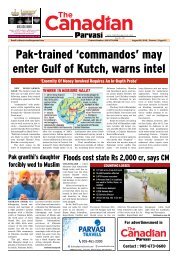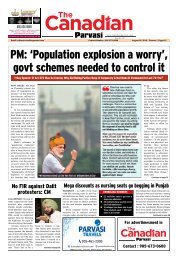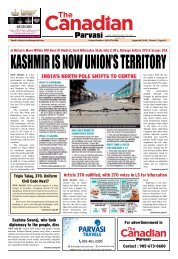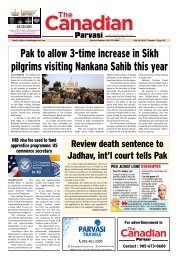Create successful ePaper yourself
Turn your PDF publications into a flip-book with our unique Google optimized e-Paper software.
<strong>The</strong> International News Weekly Edit<br />
06<br />
August 02, 2019 | Toronto<br />
<strong>The</strong><br />
w w w . canadianparv asi. c o m<br />
Publisher & CEO<br />
Associate Editor<br />
Editor (India)<br />
Online<br />
Graphic Designer<br />
Official Photographer<br />
Contact<br />
Editorial<br />
Sales<br />
Rajinder Saini<br />
Meenakshi Saini<br />
Gursheesh<br />
Kshitiz Dalal<br />
Naveen<br />
Bashir Nasir<br />
editor@canadianparvasi.com<br />
sales@canadianparvasi.com<br />
Make It Win-Win<br />
Personal laws permitting triple<br />
talaq had to go but criminalising it<br />
spawns new injustices<br />
<strong>The</strong> passage of the Muslim Women (Protection<br />
of Rights on Marriage) Bill criminalising<br />
instant oral talaq in the Rajya Sabha fulfils a<br />
BJP electoral promise. <strong>The</strong> party’s Hindutva<br />
base and even a number of Muslims opposed to<br />
the writ of religious leaders and personal laws<br />
reigning supreme in their community have<br />
welcomed the moment. By prescribing three<br />
years imprisonment for Muslim men who<br />
pronounce the talaq-e-biddat, the law sticks<br />
out with rough edges for treating divorce as a<br />
criminal offence.<br />
From a system which gave archaic personal<br />
laws a long rope for decades to now criminalising<br />
practices like triple talaq that it fostered,<br />
India is veritably swinging between extremes.<br />
<strong>The</strong> old order had to change, but it is unfortunate<br />
that the new law failed to strike a balance.<br />
Personal laws gave religious leaders disproportionate<br />
influence and denied many people, especially<br />
women, the benefits of living in a free<br />
society and under meaningful protection of the<br />
s tate. By overriding personal laws, government<br />
is indeed doing Muslim women a world of<br />
good but in failing to treat triple talaq as a civil<br />
offence, as in any other messy divorce case, it<br />
may conceivably end up doing more harm than<br />
good to the woman.<br />
A legal challenge in Supreme Court is<br />
certain to raise issues like proportionality:<br />
whether the severity of punishment befits the<br />
seriousness of the crime and whether there<br />
are less onerous ways of achieving the legislation’s<br />
goals. In a sense the social and political<br />
cost of not having a Uniform Civil Code, which<br />
would have been in tune with the secular ethos<br />
of the country, is showing. From Congress “appeasement”<br />
of minorities – or to be more precise<br />
clerics within minority communities in<br />
the hope they would deliver a “vote bank” – the<br />
pendulum has now swung to the other extreme<br />
where, under a Hindutva-oriented government,<br />
the law appears to have a punitive edge<br />
for Muslim men.<br />
In a contrary scenario, a UCC would have<br />
united the country in true fashion where citizens<br />
irrespective of religion would follow the<br />
same laws for marriage, divorce, succession,<br />
etc. This government has a manifesto that<br />
promises UCC and a mandate that can make<br />
it happen. It must bite the bullet while earning<br />
trust by upholding, rather than debunking,<br />
other aspects of secularism as well. TNN<br />
Give Rivers More Space<br />
To avoid frequent flooding havoc, India must<br />
regulate construction on floodplains<br />
Vaishnavi Chandrashekhar<br />
Last week, the Ulhas<br />
River on the outskirts of<br />
Mumbai burst its banks,<br />
swamping the land around<br />
it, including local housing<br />
estates, and stranding<br />
the passengers of the Mahalaxmi<br />
Express. <strong>The</strong> flood<br />
should not have surprised<br />
anyone: Much of the region’s<br />
exurban growth has<br />
been in townships along<br />
the Ulhas, with little regard<br />
for the integrity of the river<br />
system.<br />
India has made progress<br />
on many aspects of flood<br />
disaster management in<br />
the past decade, notably in<br />
warnings and evacuation,<br />
as we saw earlier this year<br />
when Odisha moved a million<br />
people to safety ahead<br />
of Cyclone Fani. But the<br />
country needs to catch up<br />
on a critical measure, one<br />
that is taking on greater urgency<br />
with climate change:<br />
the regulation of development<br />
on floodplains.<br />
This regulatory gap<br />
persists despite the urging<br />
of various agencies and<br />
parliamentary committees<br />
over 45 years, and for obvious<br />
reasons: developable<br />
land, especially around<br />
growing cities, is precious.<br />
If one were to quantify the<br />
true costs of real estate development<br />
in flood-prone<br />
areas, however, that calculus<br />
might be different.<br />
Reckless construction<br />
over wetlands, floodplains,<br />
or riverbeds – natural<br />
features that absorb and<br />
mitigate heavy rainfall or<br />
a river’s overflow – helped<br />
cause or aggravate the<br />
floods in Mumbai in 2005<br />
and 2017, Uttarakhand<br />
in 2013, Srinagar in 2014,<br />
Chennai in 2015 and Kerala<br />
in 2018. (Paved areas elevate<br />
flood risk by reducing absorption<br />
of water into the<br />
ground and increasing runoff.)<br />
In three of those flood<br />
events – Kochi, Chennai,<br />
Mumbai – airports, a critical<br />
piece of infrastructure,<br />
were closed for days because<br />
they were located on<br />
a floodplain, or even across<br />
the river itself.<br />
<strong>The</strong> short-sightedness<br />
of those decisions seems<br />
remarkable given how<br />
well known the concept of<br />
floodplain protection is,<br />
not just in traditional community<br />
practice but modern<br />
hydrology. In 1975, the<br />
Central Water Commission<br />
prepared a model bill for<br />
floodplain zoning and sent<br />
it to the states to enact and<br />
implement (rivers are state<br />
subjects). Only three states<br />
– Manipur, Rajasthan and<br />
Uttarakhand – have enacted<br />
such legislations so far, and<br />
even in these states, implementation<br />
is virtually absent.<br />
This regulatory shortfall<br />
is no secret. <strong>The</strong> National<br />
Disaster Management<br />
Authority’s (NDMA) Flood<br />
Guidelines observe that<br />
“the reluctance of states to<br />
enact zoning has led to increase<br />
in encroachment on<br />
floodplains, sometimes authorised<br />
and duly approved<br />
by planning authorities.”<br />
Another push for a<br />
floodplain policy came<br />
in 2016 when draft River<br />
Regulation Zone Rules, formulated<br />
with the help of<br />
independent experts, were<br />
circulated by the ministry<br />
of environment, forests, and<br />
climate change (MoEFCC).<br />
<strong>The</strong> rules proposed demarcation<br />
of active floodplains,<br />
high flood lines, and high to<br />
low impact zones, and then<br />
limiting development within<br />
these zones.<br />
What would such limits<br />
look like? NDMA’s guidelines<br />
suggest prohibiting<br />
vital public infrastructure<br />
in the most flood-prone<br />
areas along rivers. UN<br />
guidelines on flood management<br />
call for “wise use” of<br />
floodplains. <strong>The</strong>y suggest<br />
wetlands, agriculture and<br />
green reserves along water<br />
courses that will not only<br />
act as buffers against flood<br />
but nurse fisheries and enable<br />
storage and recharge of<br />
groundwater. In less risky<br />
zones, building codes would<br />
be needed to reduce flood<br />
damage to homes.<br />
<strong>The</strong> MoEFCC’s draft<br />
river rules were opposed by<br />
many states, presumably<br />
because of the political and<br />
practical challenges of implementing<br />
them in heavily<br />
populated areas with lots<br />
of rivers. Local community<br />
participation can help overcome<br />
some of those challenges.<br />
So will flood hazard<br />
mapping and publication.<br />
Imagine if builders were<br />
forced to publicise the flood<br />
risk rating of their projects<br />
along with carpet area and<br />
parking.<br />
Globally, the rise in<br />
extreme events is forcing<br />
a rethink on flood management.<br />
Floods are the most<br />
common kind of disaster,<br />
accounting for 47% of<br />
worldwide disasters in 2006-<br />
15, up from 40% in 1996-2005,<br />
according to the UN Office<br />
for Disaster Risk Reduction.<br />
One 2017 analysis suggests<br />
that 4.48 million Indians are<br />
exposed to riverine floods,<br />
the highest in the world.<br />
In the US, which has<br />
long managed floods<br />
through hazard mapping<br />
and public insurance –<br />
cover is mandatory for<br />
mortgages in 100-year flood<br />
zones – rising risk is pushing<br />
up premiums.<br />
<strong>The</strong> World Meteorological<br />
Organisation now promotes<br />
integrated flood management<br />
that includes land<br />
use planning in its arsenal<br />
of anti-flood measures. And<br />
in Europe, a 2007 directive<br />
is encouraging countries to<br />
expand beyond the traditional<br />
flood control of dams<br />
and dykes to include more<br />
natural measures, including<br />
restoring floodplains to<br />
“give rivers more space”.<br />
That would require<br />
seeing rivers not as static<br />
channels – as many of India’s<br />
urban waterfront projects<br />
seem to be doing – and<br />
more as dynamic systems<br />
in which riverbanks and<br />
floodplains are not treated<br />
as real estate but as elbow<br />
room for the river, allowing<br />
it to expand and contract<br />
over the seasons.<br />
Such a rethink does<br />
not seem to be happening<br />
in India, or at least not fast<br />
enough. Despite the lessons<br />
of past floods, Maharashtra<br />
deleted its River Regulation<br />
Zone policy in 2015 – a decision<br />
now being protested<br />
by residents near the Ulhas<br />
River – and decided<br />
to build a new airport in<br />
Navi Mumbai on low-lying<br />
land. Nationally the relaxation<br />
of coastal regulation<br />
zone (CRZ) rules allows<br />
more risk to accumulate in<br />
coastal areas which face the<br />
additional threat of sea level<br />
rise.<br />
Preserving natural land<br />
use – forests, river banks,<br />
wetlands – is often painted<br />
as antithetical to development,<br />
a false dichotomy<br />
that is not only outdated but<br />
dangerous in an age of extreme<br />
weather.<br />
Climate change is showing<br />
us the economic costs of<br />
ignoring the environment,<br />
the limits to our ability to<br />
bind and control nature,<br />
and the advantages of working<br />
with natural systems<br />
rather than against them.<br />
Source Credit: This article<br />
was first published in <strong>The</strong> Times<br />
of India.<br />
<strong>Parvasi</strong> weekly & people associated with it are not responsible for any claims made by the advertisement & do not endorse any product or service advertised in <strong>Canadian</strong> <strong>Parvasi</strong>. Please consult your lawyer before buying/hiring/contracting through the<br />
advertisement Publised in this newspaper. <strong>The</strong> <strong>Canadian</strong> <strong>Parvasi</strong> is in the business of selling space and the clains made by the advertisement are not tested/confirmed by an independent source.
















